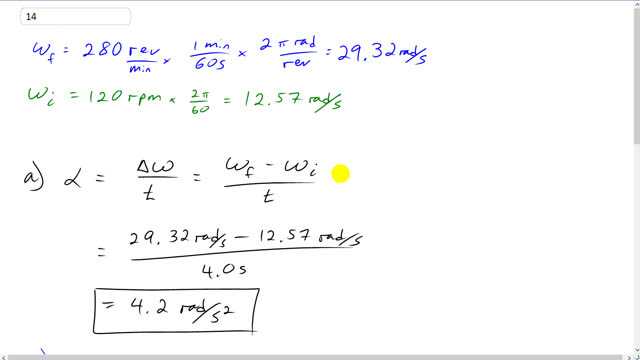
A 61-cm-diameter wheel accelerates uniformly about its center from 120 rpm to 280 rpm in 4.0 s. Determine
- its angular acceleration, and
- the radial and tangential components of the linear acceleration of a point on the edge of the wheel 2.0 s after it has started accelerating.

In order to watch this solution you need to have a subscription.
This is Giancoli Answers with Mr. Dychko. Angular acceleration is the change in angular velocity divided by the time over which that change occurs. So we have the final angular velocity minus the initial divided by time and I converted each of these 'rpm' or revolutions per minute into radians per second in order to work nicely in these formulas since we have seconds on the bottom, we need the top to be in radians per second. So we take the 280 revolutions per minute times by 1 minute for 60 seconds and then times by a full circle 2π radians for every revolution and you end up with 29.32 radians per second is the final angular velocity. The initial angular velocity is well, 120 rpm times 2π over 60 is what ends up happening here, 12.57. So the angular acceleration is that difference in angular velocities divided by 4 seconds which is 4.2 radians per second squared. For part (b), we need to figure out the radial acceleration and the tangental acceleration after 2 seconds so we need to know what is the angular velocity at that time because the radial acceleration will be the angular velocity at 2 seconds squared times the radius of the wheel. So angular velocity final is angular velocity initial plus the angular acceleration times time. So that's 12.57 radians per second times 4.1875 radians per second squared times 2 seconds or 20.95 radians per second for the angular velocity at 2 seconds. So we plug that in, square it times by the radius of 61 times 10 to the minus 2 meters divided by 2— this is the 61 centimeter diameter, we convert into meters by multiplying by 10 to the minus 2 and then divide by 2 to get radius— and this is 130 meters per second squared is the radial acceleration towards the center. The tangental acceleration is the radius multiplied by the angular acceleration. So 61 times 10 to the minus 2 meters over 2 for the radius times by 4.188 radians per second squared which gives 1.3 meters per second squared tangental acceleration.